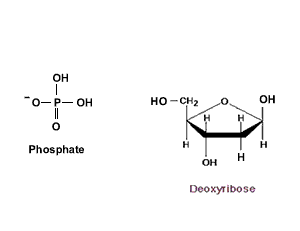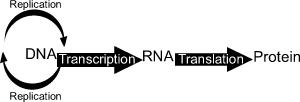DNA - a natural condensation polymer

A single strand of DNA is formed from a phosphate, sugar (deoxyribose), backbone which has bases such as adenine, guanine, thymine or cytosine attached. This is an example of a condensation polymerisation reaction where one water molecule is released every time a link is formed, as shown on the right.
The subunits that form the DNA and RNA polymers are known as nucleotides and consist of a phosphate, sugar and base units.

The DNA molecule is composed of two strands, as shown on the right, linked together by hydrogen bonding. The two strands twist around each other forming a helical structure, as shown by the animation above. Notice how cytosine and guanine bond together and thymine and adenine bond together. This type of pairing means that the base sequence on one strand is complementary to the sequence on the other strand. For example if adenine is bonded on one strand there should be a thymine bonded opposite on the other strand.
Three major differences become apparent when looking at the DNA and RNA polymers.
One is that the backbone of RNA has ribose rather than deoxyribose as the sugar.
The second difference is that the base thymine is replaced by uracil.
The third is that RNA is a single stranded polymer where as DNA is a double stranded helical polymer.

A summary of the role of nucleic molecules and protein is shown on the right.
DNA undergoes self replication to produce more DNA and transcription to produce RNA. RNA is then translated to protein.
